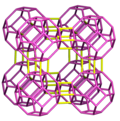Molecular sieve
Molecular sieve is a material with pores (very small holes) of uniform size. These pores are small enough to block large molecules and allow smaller molecules to pass through, making molecular sieves useful for separating and purifying gases and liquids. They are often used in the chemical, petrochemical, and natural gas industries, among others, to remove water or other impurities from process streams.
Types of Molecular Sieves
Molecular sieves are classified by their pore size, typically measured in angstroms (Å), and can be made from various materials, including zeolites, carbon, silica gel, and others. The most common types include:
- 3A: With a pore size of 3 Å, it is used primarily for drying, removing water from gases and liquids.
- 4A: With a pore size of 4 Å, it can remove water, but also gases like CO2, SO2, and H2S from streams.
- 5A: With a pore size of 5 Å, it is used for separating hydrocarbons, purifying gas streams, and in air separation.
- 13X: With a pore size of approximately 10 Å, it is used for general gas drying, air separation, and the removal of CO2 and H2S.
Applications
Molecular sieves have a wide range of applications due to their ability to selectively adsorb molecules based on size. Some common applications include:
- Gas and Liquid Drying: Removing water from natural gas, air, and refrigerants.
- Air Separation: Separating oxygen, nitrogen, and other gases from air.
- Purification: Removing impurities like CO2, SO2, H2S, and mercaptans from gas streams.
- Catalysis: Acting as catalysts in various chemical reactions due to their unique pore structures.
Advantages
Molecular sieves offer several advantages over other drying and purification methods:
- High Selectivity: Their uniform pore sizes allow for the selective adsorption of molecules.
- High Capacity: They can adsorb a large amount of material relative to their weight.
- Regenerability: Molecular sieves can be regenerated (dried or cleaned) and reused multiple times by heating or reducing pressure.
Regeneration
Regeneration of molecular sieves involves removing the adsorbed substances from the sieve's pores. This is typically done by either increasing the temperature (thermal swing adsorption) or reducing the pressure (pressure swing adsorption) to desorb the adsorbed material.
Safety and Handling
While molecular sieves are generally safe to handle, they can cause skin dryness or irritation due to their high adsorption capacity. Proper personal protective equipment (PPE) should be used when handling them.
Environmental Impact
Molecular sieves are considered environmentally friendly due to their regenerability and efficiency in purifying and separating gases and liquids without the use of harmful chemicals.
See Also
References
External Links
Molecular sieve gallery
Transform your life with W8MD's budget GLP-1 injections from $125.
W8MD offers a medical weight loss program to lose weight in Philadelphia. Our physician-supervised medical weight loss provides:
- Most insurances accepted or discounted self-pay rates. We will obtain insurance prior authorizations if needed.
- Generic GLP1 weight loss injections from $125 for the starting dose.
- Also offer prescription weight loss medications including Phentermine, Qsymia, Diethylpropion, Contrave etc.
NYC weight loss doctor appointments
Start your NYC weight loss journey today at our NYC medical weight loss and Philadelphia medical weight loss clinics.
- Call 718-946-5500 to lose weight in NYC or for medical weight loss in Philadelphia 215-676-2334.
- Tags:NYC medical weight loss, Philadelphia lose weight Zepbound NYC, Budget GLP1 weight loss injections, Wegovy Philadelphia, Wegovy NYC, Philadelphia medical weight loss, Brookly weight loss and Wegovy NYC
|
WikiMD's Wellness Encyclopedia |
| Let Food Be Thy Medicine Medicine Thy Food - Hippocrates |
Medical Disclaimer: WikiMD is not a substitute for professional medical advice. The information on WikiMD is provided as an information resource only, may be incorrect, outdated or misleading, and is not to be used or relied on for any diagnostic or treatment purposes. Please consult your health care provider before making any healthcare decisions or for guidance about a specific medical condition. WikiMD expressly disclaims responsibility, and shall have no liability, for any damages, loss, injury, or liability whatsoever suffered as a result of your reliance on the information contained in this site. By visiting this site you agree to the foregoing terms and conditions, which may from time to time be changed or supplemented by WikiMD. If you do not agree to the foregoing terms and conditions, you should not enter or use this site. See full disclaimer.
Credits:Most images are courtesy of Wikimedia commons, and templates, categories Wikipedia, licensed under CC BY SA or similar.
Contributors: Prab R. Tumpati, MD



